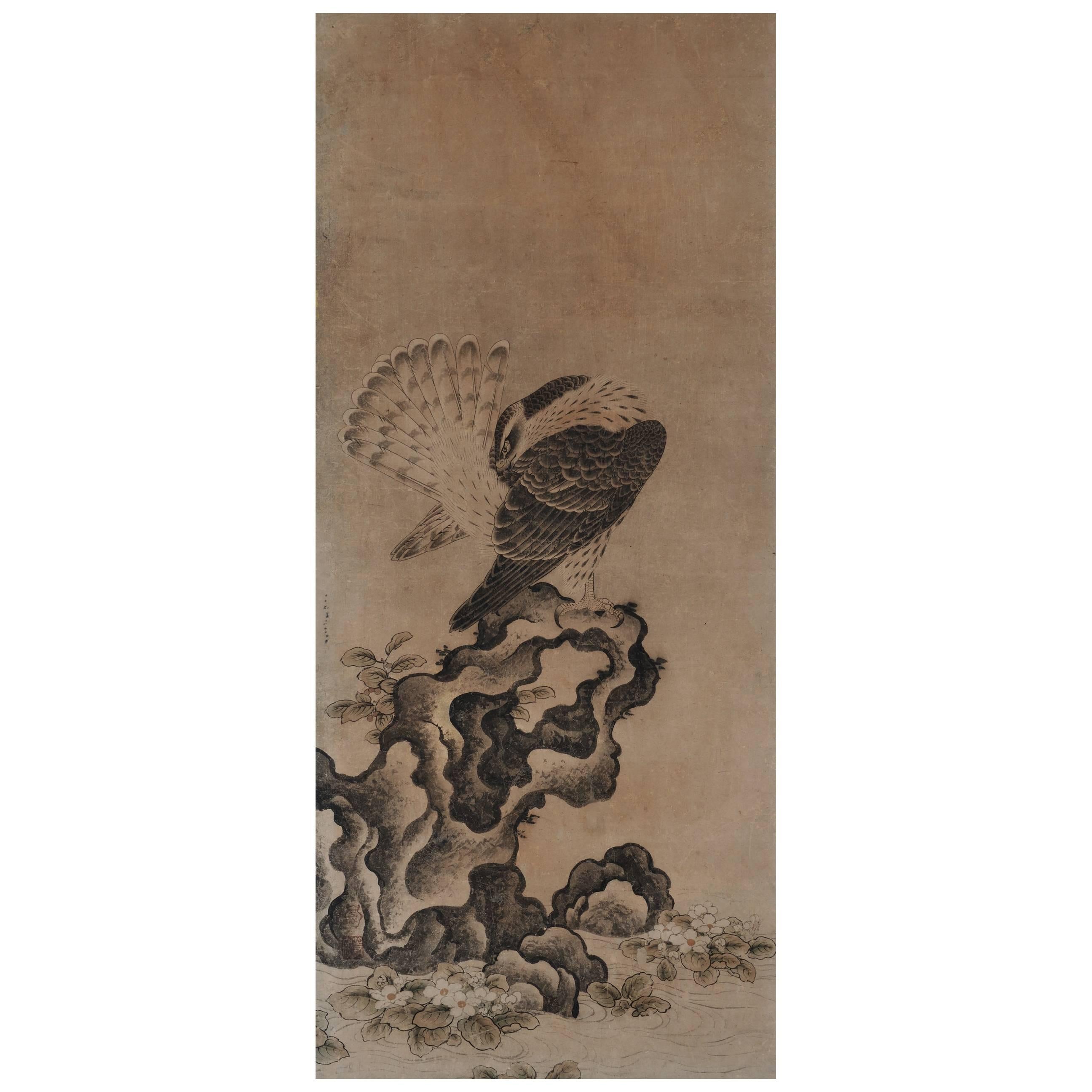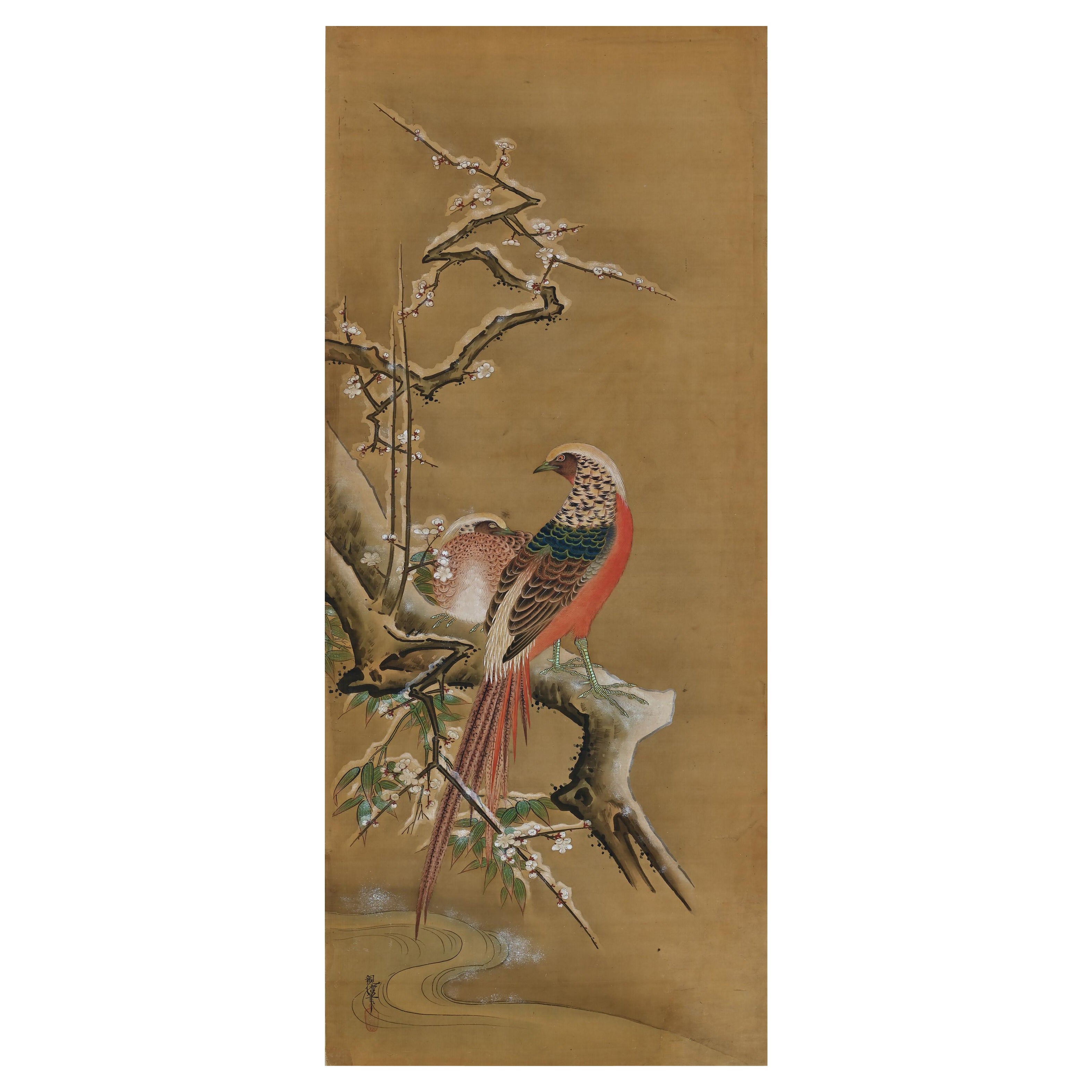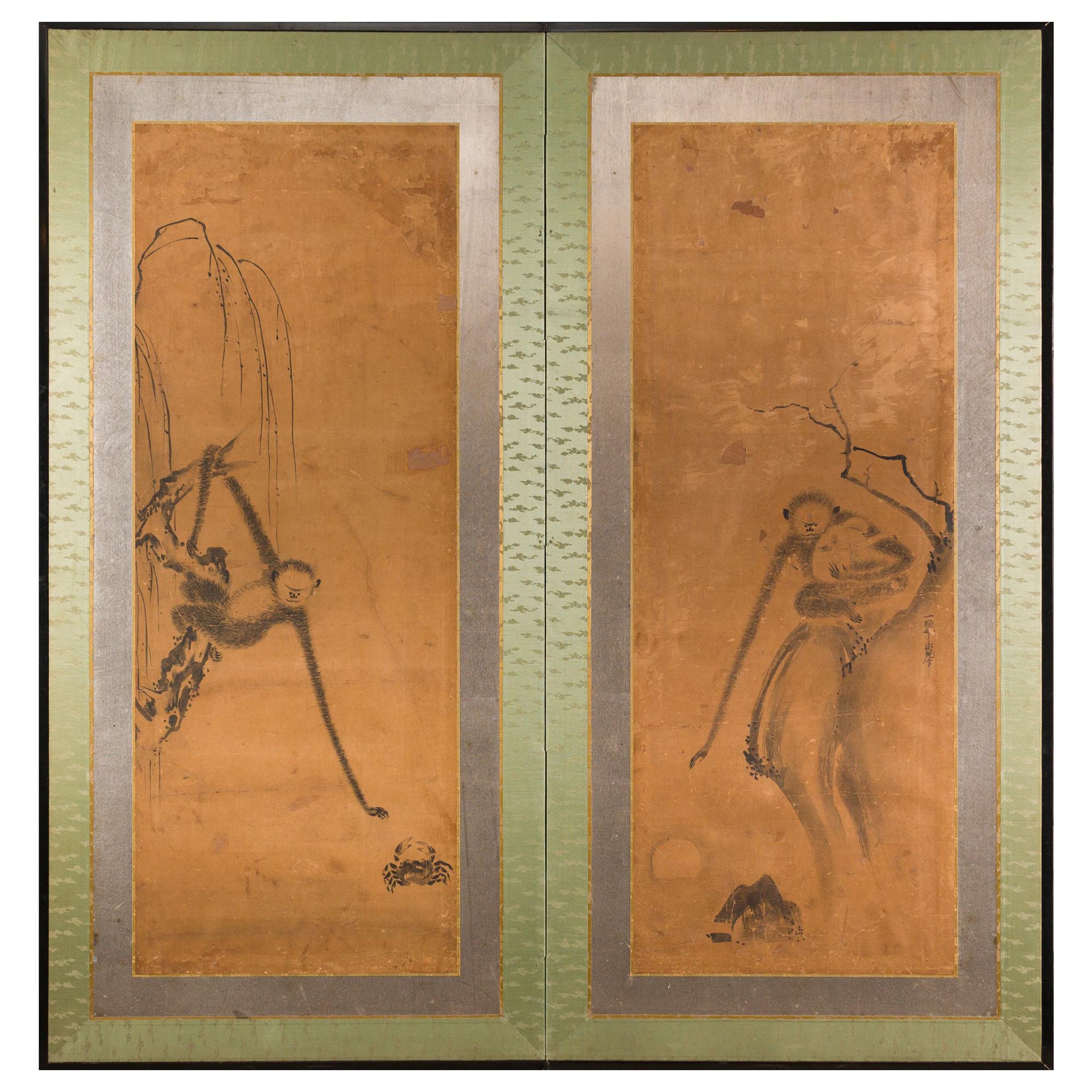Items Similar to 17th Century Japanese Framed Panel by Kano Sansetsu, White Herons in Snow
Want more images or videos?
Request additional images or videos from the seller
1 of 5
17th Century Japanese Framed Panel by Kano Sansetsu, White Herons in Snow
About the Item
Kano Sansetsu (1589-1651)
White herons in snow
Edo period, circa 1640
Framed painting. Ink on paper.
Kano Sansetsu is a Japanese painter who represented the Kyo Kano (Kyoto Kano) school from the end of Momoyama to the early Edo period. At first, he was a student of Kano Sanraku, but later became his son-in-law and inherited the family lineage. The era when Sanraku and Sansetsu lived was a turbulent period when the administration of Japan changed from the Toyotomi the Tokugawa. Not only the Daimyo but also the Kano school painters had their fates greatly influenced by the whirlpool of the times. Sanraku and Sansetsu were fortunate to survive the upheaval. At that time the majority of the Kano school, along with Kano Tanyu, moved to Tokyo and began working for the Edo Shogunate. In contrast to this Edo Kano, which developed a light and stylish mode of painting, the artists remaining in Kyoto continued to develop a rich and powerful painting style.
Kano Sansetsu’s paintings have many unique aspects. He persistently pursuits form and design, and his compositions often strongly contrast light and dark. His decorative flair is born of a vigorous geometry that emphasizes the vertical and horizontal, and his novel compositions reinterpret traditional themes based on a deep knowledge of old paintings. His works, which are full of unique stimuli, pioneered the subsequent appearances of Ito Jakucho and Soga Shohaku, and continue to influence many artists today. In 2019 Sansetsu was one of eight artists whose works were exhibited in the ‘Lineage of Eccentrics: The Miraculous World of Edo Painting’ at the Tokyo Metropolitan Art Museum. His set of sliding doors held at the Metropolitan Museum of Art, ‘Old Plum’, are amongst the most recognizable Japanese works of art held outside of Japan. In 2010 LACMA purchased a two-panel folding screen of a tiger drinking from a river by Kano Sansetsu. Apparently it was the only signed screen by the artist to ever leave Japan. Large scale works by him are also held at various temples in Kyoto, including Kiyomizu-dera, Myoshin-ji, Tofuku-ji, Sennyu-ji and Higashi Honganji.
- Dimensions:Height: 47 in (119.38 cm)Width: 21 in (53.34 cm)Depth: 1 in (2.54 cm)
- Style:Edo (Of the Period)
- Materials and Techniques:
- Place of Origin:
- Period:
- Date of Manufacture:circa 1640
- Condition:Refinished. Repaired: The paper painting is mounted on a panel, the frame of roiro mirror-polished, black lacquer. Conservation, mounting and framing was carried out in Kyoto utilizing traditional techniques and craftsmen. Minor losses.
- Seller Location:Kyoto, JP
- Reference Number:1stDibs: LU2472320883592
About the Seller
5.0
Recognized Seller
These prestigious sellers are industry leaders and represent the highest echelon for item quality and design.
Established in 2001
1stDibs seller since 2016
60 sales on 1stDibs
Typical response time: 6 hours
- ShippingRetrieving quote...Ships From: Kyoto, Japan
- Return PolicyA return for this item may be initiated within 10 days of delivery.
More From This SellerView All
- 17th Century Japanese Framed Painting by Kano Sansetsu, Plum Blossoms in SnowLocated in Kyoto, JPKano Sansetsu (1589-1651) Plum blossoms in snow Edo period, circa 1640 Framed painting. Ink on paper. Kano Sansetsu is a Japanese painter who...Category
Antique 17th Century Japanese Edo Paintings and Screens
MaterialsPaper
- Japanese Painting, Framed Panel, 17th Century Falcon by Mitani ToshukuBy Mitani ToshukuLocated in Kyoto, JPMitani Toshuku (1577-1654) “Falcon” Wall panel, ink and light color on paper. Upper seal: Mitani Lower seal: Toshuku Dimensions: Each 118.5 cm x 51 cm x 2 cm (46.5” x 20” x .75”) Individual falcon paintings by Mitani Toshuku (1577-1654), an early artist of the Unkoku School. Founded by Unkoku Togan (1547–1618), a master of the Momoyama period, the Unkoku school enjoyed long lasting patronage in southern Japan. Togan was a retainer of the Mori family in present day Yamaguchi prefecture. Members of the school considered themselves to be in the artistic lineage of Sesshu Toyo...Category
Antique Early 17th Century Japanese Edo Paintings and Screens
MaterialsWood, Paper
- 17th Century Japanese Screen. Ink Plum Tree & Birds by Kano Naonobu.Located in Kyoto, JPKano Naonobu (1607-1650) Plum Tree and Birds Six-fold Japanese Screen. Ink and slight color on paper. In this evocative ink work spread over a six-panel folding screen, we see the consummation of the elegance and refinement of the Edo Kano school. This 17th century screen is a rare surviving example of a large-scale bird and flower painting by Kano Naonobu, the younger brother of Kano Tanyu...Category
Antique 17th Century Japanese Edo Paintings and Screens
MaterialsWood, Paper
- 19th Century Japanese Silk Painting by Kano Chikanobu, Pheasants & Plum in SnowLocated in Kyoto, JPBirds & Flowers of the Seasons Pheasants & Plum in Snow Ink, pigment and gofun on silk Kano Chikanobu 1819-1888 Signature: Chikanobu Seal: Shateki Offered here is an unframed ‘kacho-e’ painting by the 19th century Japanese Takamatsu domain painter Kano Chikanobu. There are 8 individual paintings available, which originally would have been part of a set of 12. ‘Kacho-e’ literally means ‘pictures of birds and flowers’. In reality it covers a wide range of natural motifs including birds, fish, insects and small animals in combination with flowers, grasses or trees. The theme has a long history in Japanese painting. It is one of three painting genres, the other two being landscape and figure, which derive from Chinese academic painting classification. As one of the accepted types of painting to be shown in official residences, scenes of birds, flowers and animals were rife with metaphorical reference as well as physical beauty. In these paintings Chikanobu has made conspicuous use of brilliant pigments and meticulous brushwork. The rocks, water, trees, blossoms, and birds are treated as stylized formal elements in a grand design. All of the components contribute to the patterned effect and tactile richness of the surface. Beyond their highly decorative qualities, the subject of some of the paintings are also an allusion to imperial allegiance; the pheasants are symbolic of bravery and steadfastness, peacocks represent divinity and power, and the phoenix paired with paulownia a just and benevolent ruler. Cranes and turtles symbolize longevity, and the lush, full bloom of the peony flower represents wealth and opulence. Paintings of native Japanese birds and flowers were appreciated primarily for their evocation of the seasons and the traditional poetic emotions associated with them. This is the case with the spring scene of cherry blossoms and birds and the winter scene of narcissus, nandina and sparrows. The rich expression of flower and bird paintings...Category
Antique Mid-19th Century Asian Edo Paintings and Screens
MaterialsSilk
- 17th Century Japanese Screen Pair, CranesLocated in Kyoto, JPCranes Anonymous, Kano School. Edo period, second half of the 17th century. Pair of six-panel screens. Ink, pigment gofun and gold l...Category
Antique 1670s Japanese Edo Paintings and Screens
MaterialsGold Leaf
- 17th Century Japanese Screen Pair. Tiger & Dragon by Kaiho YusetsuLocated in Kyoto, JPKaiho Yusetsu (1598-1677) Tiger and Dragon Early Edo Period, Circa 1650 A Pair of Six-fold Japanese Screens. Ink and slight color on paper. Dimensions: Each screen: H. 171 cm x W. 380 cm (67.5’’ x 149.5’’) In this pair of early Edo period Japanese screens a group of tigers prowl in a bamboo grove whipped with fierce wind, while a dragon claws through clouds and mist. The dragon embodies elemental qualities - looming out of the mist, the coils of its body disappearing in the clouds. The dragon is calling for rain, symbolizing spring which is considered the fountain of life. On the other side, the tigers calls for the wind, symbolizing autumn which is considered the end of life. Tigers were familiar motifs within Japanese art from ancient times though the animals were imaginary to the people in the 17th century. While dragons and tigers are usually associated as sacred and ferocious, in this painting, both animals have rather amusing expressions. The tigers appear to glare at the dragon with cat-like eyes, and the look on the swirling dragon’s face appears almost affectionate - lending a playful flair to an otherwise magnificent theme. The tiger and dragon are cosmological symbols of the balancing forces in the world. Screens such as this were originally meant to express the fluctuating nature of the world. For Japanese in the early Edo period, they likely suggested the powers of the cosmos. In Japan the tiger and dragon motif was originally absorbed into the circles of Zen monasteries before spreading into the secular world. The theme especially appealed to the military classes with the Kano school, the official painters to the Shogun and the samurai, being the leading contributors. The painter of this pair of screens, Kaiho Yusetsu (1598-1677), was closely patronized by the third Shogun Tokugawa Iemitsu. In his later years he worked with Kano school artists...Category
Antique Mid-17th Century Japanese Edo Paintings and Screens
MaterialsSilk, Wood, Paper
You May Also Like
- 17th Century Japanese Two-Panel Screen, Gibbons of FolkloreLocated in Hudson, NYJapanese two-panel screen: Gibbons of Folklore, Edo period (17th century) Kano School painting of gibbons in Japanese fables. The left panel represents a Japanese fable of a monkey a...Category
Antique Late 17th Century Japanese Edo Paintings and Screens
MaterialsSilk, Wood, Paper
- 19th Century Japanese Edo Six Panel Kano School Landscape ScreenLocated in Rio Vista, CALate Edo period 19th century Japanese six-panel landscape screen featuring a cypress tree over a flowering hibiscus with a pair of hototogisu birds. Kano school painted with ink and ...Category
Antique 19th Century Japanese Edo Paintings and Screens
MaterialsSilk, Wood, Paper
- Antique Japanese Suibokuga Egrets by Kano Tokinobu, 17th century.Located in Point Richmond, CAAntique Japanese Suibokuga Egrets by Kano Tokinobu, 17th century. A sumi-e ink on paper painting illustrating two egrets in reserve with no outlines contrasting with the reeds from the marsh in the background. The painting with 3 vermillion seals of the artist in the lower left corner. Japanese dry mount paper on a wood frame with thin brocade border silver leafed surround and lacquered wood outer frame. Condition: Lighter discoloration on the lower portion of the painting, other minor signs of age, wear, stains and repairs otherwise fine condition. Age: Painting Edo Period, circa 1670. Mounting circa 1985. Image: 51-1/2 in. x 20-1/2 in. (131cm x 52cm) Frame 59-1/4 in. x 25-1/4 in. (150cm x 64cm) Weight: 6 lbs. Provenance: with Honeychurch Antiques...Category
Antique 1670s Japanese Edo Paintings and Screens
MaterialsPaper
- Antique Japanese Suibokuga Sage by Kano Tokinobu, 17th century.Located in Point Richmond, CAAntique Japanese Suibokuga Sage Painting by Kano Tokinobu, 17th century. A sumi-e ink on paper painting illustrating an acolyte at a riverbank. The image of the standing Chinese figure with elongated earlobes (a symbol of enlightenment), hair tied back in a kerchief and long beard, holds a large fan in his left hand to his right shoulder. The long robes are windswept with water curls about the figures feet. The painting with 3 vermillion seals of the artist in the lower left corner. Japanese dry mount paper on a wood frame with thin brocade border silver leafed surround and lacquered wood outer frame. Condition: Paper restoration on center, a quarter of an inch of the left edge of the painting is added, other minor signs of age, wear, stains and repairs overall fine condition. Age: Painting Edo Period, circa 1670. Mounting circa 1985. Image: 51-1/2 in. x 20-1/2 in. (131cm x 52cm) Frame: 59-1/4 in. x 25-1/4 in. (150cm x 64cm) Weight: 6lbs. Provenance: with Honeychurch Antiques...Category
Antique 1670s Japanese Edo Paintings and Screens
MaterialsPaper
- Antique Japanese Suibokuga Landscape by Kano Tokinobu, 17th century.Located in Point Richmond, CAAntique Japanese Suibokuga Landscape by Kano Tokinobu, 17th century. A sumi-e ink on paper painting illustrating a rocky seaside landscape containing buildings, vegetation and ship masts. The painting with 3 vermillion seals of the artist in the lower left corner. Japanese dry mount paper on a wood frame with thin brocade border silver leafed surround and lacquered wood outer frame. Condition: Lighter discoloration near the bottom of the painting, various paper restorations, other minor signs of age, wear, stains, otherwise fine condition. Age: Painting Edo Period, circa 1670. Mounting circa 1985. Image: 51-1/2 in. x 20-1/2 in. (131cm x 52cm) Frame: 59-1/4 in. x 25-1/4 in. (150cm x 64cm) Weight: 6 lbs. Provenance: with Honeychurch Antiques...Category
Antique 1670s Japanese Edo Paintings and Screens
MaterialsPaper
- Antique Japanese Suibokuga Landscape by Kano Tokinobu, 17th century.Located in Point Richmond, CAAntique Japanese Suibokuga Landscape by Kano Tokinobu. 17th century. A sumi-e ink on paper painting illustrating an ethereal mountainous landscape at the seashore containing buildings, trees, birds and ship masts. 3 vermillion seals of the artist in the lower right hand corner. Japanese dry mount paper on a wood frame with thin brocade border silver leafed surround and lacquered wood outer frame. Condition: Minor signs of age, wear, otherwise fine condition. Age: Painting Edo Period, circa 1670. Mounting circa 1985. Image: 51-1/2 in. x 20-1/2 in. (131cm x 52cm) Frame: 59-1/4 in. x 25-1/4 in. (150cm x 64cm) Weight: 6 lbs. Provenance: with Honeychurch Antiques...Category
Antique 1670s Japanese Edo Paintings and Screens
MaterialsPaper
Recently Viewed
View AllMore Ways To Browse
17th Panel
17th Century Panel
Japanese Influence Furniture
Antique White Scale
Framed Asian Panels
Traditional Asian Painting
Large Framed Asian Art
Large Screen Panel
Japanese Hand Painted Panel
Screen Doors Used
Japanese Screens Large
Antique Decorative Screens
Edo Paint
Used Screen Doors
Decorative Screen Panel
Two Panel Folding
Framed Japanese Panel Painting
Horizontal Japanese





